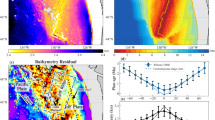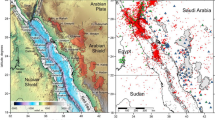Abstract
The crenulated geometry of the Southeast Indian ridge within the Australian-Antarctic discordance is formed by numerous spreading ridge segments that are offset, alternately to the north and south, by transform faults. Suggested causes for these offsets, which largely developed since ~ 20 Ma, include asymmetric seafloor spreading, ridge jumps, and propagating rifts that have transferred seafloor from one flank of the spreading ridge to the other. Each of these processes has operated at different times in different locations of the discordance; here we document an instance where a small (~ 20 km), young (< 0.2 Ma), southward ridge jump has contributed to the observed asymmetry. When aeromagnetic anomalies from the Project Investigator-1 survey are superposed on gravity anomalies computed from Geosat GM and ERM data, we find that in segment B4 of the discordance (between 125° and 126° E), the roughly east-west-trending gravity low, correlated with the axial valley, is 20–25 km south of the ridge axis position inferred from the center of magnetic anomaly 1. Elsewhere in the discordance, the inferred locations of the ridge axis from magnetics and gravity are in excellent agreement. Ship track data confirm these observations: portions of Moana Wave track crossing the ridge in B4 show that a topographic valley correlated with the gravity anomaly low lies south of the center of magnetic anomaly 1; while other ship track data that cross the spreading ridge in segments B3 and B5 demonstrate good agreement between the axial valley, the gravity anomaly low, and the central magnetic anomaly. Based on these observations, we speculate that the ridge axis in B4 has recently jumped to the south, from a ridge location closer to the center of the young normally magnetized crust, to that of the gravity anomaly low. The position of the gravity low essentially at the edge of normally magnetized crust requires a very recent (< 0.2 Ma) arrival of the ridge in this new location. Because this ridge jump is so young, it may be a promising location for future detailed studies of the dynamics, kinematics, and thermal effects of ridge jumps.
Similar content being viewed by others
References
Cande, S. C. and Kent, D. V., 1992, A new geomagnetic polarity time scale for the Late Cretaceous and Cenozoic,J. Geophys. Res. 97, 13,917–13,952.
Cande, S. C. and Mutter, J. C., 1982, A revised identification of the oldest sea-floor spreading anomalies between Australia and Antarctica,Earth and Planet Sci. Letts. 58, 151–160.
Chen, Y. C. and Morgan, W. J., 1990, A nonlinear rheology model for mid-ocean ridge axis topography,J. Geophys. Res. 95, 17,583–17,604.
Cochran, J. R., 1986, Variations in subsidence rates along intermediate and fast spreading mid-ocean ridges,Geophys. J. R. Astron. Soc. 87, 421–454.
Forsyth, D. W., Ehrenbard, R. L., and Chapin, S., 1987, Anomalous upper mantle beneath the Australian-Antarctic discordance,Earth and Planet Sci. Letts. 84, 471–478.
Hayes, D. E., 1976, Nature and implications of asymmetric seafloor spreading — “Different rates for different plates,”Geol. Soc. Am. Bull. 87, 994–1002.
Hey, R., 1979, Evidence for spreading-center jumps from fine-scale bathymetry and magnetic anomalies near the Galapagos Islands,Geology 7, 504–506.
Hey, R., Duennebier, F. K., and Morgan, W. J., 1980, Propagating rifts on midocean ridges,J. Geophys. Res. 85, 3647–3658.
Hey, R. N. and Wilson, D. S., 1982, Propagating rift explanation for the tectonic evolution of the northeast Pacific — the pseudomovie,Earth and Planet. Sci. Letts. 58, 167–188.
Jonas, J., Hall, S. A., and Casey, J. F., 1991, Gravity anomalies over extinct spreading centers: A test of gravity models of active centers,J. Geophys. Res. 96, 11,759–11,777.
Klein, E. M. and Langmuir, C. H., 1987, Global correlations of ocean ridge basalt chemistry with axial depth and crustal thicknesses,J. Geophys. Res. 92, 8089–8115.
Mammerickx, J., 1992, The Foundation seamounts: tectonic setting of a newly discovered seamount chain in the South Pacific,Earth and Planet Sci. Letts. 113, 293–306.
Mammerickx, J. and Sandwell, D., 1986, Rifting of oceanic lithosphere,J. Geophys. Res. 91, 1975–1988.
Marks, K. M., McAdoo, D. C., and Sandwell, D. T., 1991, Geosat GM data reveal new details of ocean floor,EOS Trans. AGU 72, 145–149.
Marks, K. M., McAdoo, D. C., and Smith, W. H. F., 1993a, Mapping the Southwest Indian ridge with Geosat,EOS Trans. AGU 74, 81–86.
Marks, K. M., McAdoo, D. C., and Smith, W. H. F., 1993b, Geosat gravity anomaly grid south of 30° S, in Global Relief Data on CD-ROM,Data Ann. 93-MGG-01., Natl. Geophys. Data Center, NOAA, Boulder, Colorado.
Marks, K. M. and Stock, J. M., 1993, Tectonic details of the Australian-Antarctic discordance from Geosat gravity and magnetic anomaly identifications (abstract),EOS Trans. AGU 74, Spring Meeting suppl., 99.
Marks, K. M. and Stock, J. M., 1994, Tectonic development of the Australian-Antarctic discordance (abstract),EOS Trans. AGU 75, Spring Meeting suppl., 321.
Morgan, G. A., Fleming. H. S., and Feden, R. H., 1979, Project Investigator-1: A cooperative US/Australian airborne geomagnetic study south of Australia, in:Proc 13th Int. Symp. Remote Sens. Environ. III pp. 1439–1444.
Morgan, J. P. and Sandwell, D. T., 1994, Systematics of ridge propagation south of 30° S,Earth and Planet Sci. Letts. 121, 245–258.
Neumann, G. A., Forsyth, D. W., and Sandwell, D., 1993, Comparison of marine gravity from shipboard and high-density satellite altimetry along the Mid-Atlantic ridge, 30.5°–35.5° S,Geophys. Res. Letts. 20, 1639–1642.
Palmer, J., Sempéré, J.-C., Christie, D. M., and Morgan, J. P., 1993, Morphology and tectonics of the Australian-Antarctic discordance between 123° E and 128° E,Marine Geophys. Res. 15, 121–152.
Royer, J.-Y. and Sandwell, D. T., 1989, Evolution of the eastern Indian Ocean since the Late Cretaceous: Constraints from Geosat altimetry,J. Geophys. Res. 94, 13,755–13,782.
Ryan, W. B., Raymond, C. A., Cande, S. C., Haxby, W. F., Tebbens, S., O'Hara, S., Mueller, D., O'Brien, B., and Wilkinson, M., 1992, Documentation of ridge-axis jumps on the Pacific-Antarctic spreading center (abstract),EOS Trans. AGU. 73, Spring Meeting suppl., 295.
Sempéré, J.-C., Palmer, J., Christie, D. M., Morgan, J. P., Shor, A. N., 1991, Australian-Antarctic discordance,Geology 19, 429–432.
Smith, W. H. F., Sandwell, D. T., Marks, K. M., and McAdoo, D. C., 1993, On the accuracy of marine gravity fields calculated from satellite altimetry (abstract),EOS Trans. AGU. 74, Spring Meeting suppl., 99.
Vogt, P. R., Cherkis, N. Z., and Morgan, G. A., 1983, Project Investigator-1: Evolution of the Australian-Antarctic discordance deduced from a detailed aeromagnetic study, in Oliver, R. L., James, P. R., and Jago, J., (eds.),Antarctic Earth Science: Proc. 4th Int. Symp. Ant. Earth Sci. Australian Academy Sci., Canberra, pp. 608–613.
Weissel, J. K. and Hayes, D. E., 1971, Asymmetric seafloor spreading south of Australia,Nature 231, 518–522.
Weissel, J. K. and Hayes, D. E., 1974, The Australian-Antarctic discordance: New results and implications,J. Geophys. Res. 79, 2579–2587.
West, B.P., Sempéré, J.-C., Pyle, D.G., Morgan, J.P., and Christie, D.M., 1994, Evidence for variable upper mantle temperature and crustal thickness in and near the Australian-Antarctic Discordance,Earth and Planet. Sci. Letts. 128, 135–153.
Author information
Authors and Affiliations
Additional information
The U.S. Government right to retain a non-exclusive, royalty-free license in and to any copyright is acknowledged.
Rights and permissions
About this article
Cite this article
Marks, K.M., Stock, J.M. Asymmetric seafloor spreading and short ridge jumps in the Australian-Antarctic discordance. Mar Geophys Res 17, 361–373 (1995). https://doi.org/10.1007/BF01227040
Received:
Accepted:
Issue Date:
DOI: https://doi.org/10.1007/BF01227040




